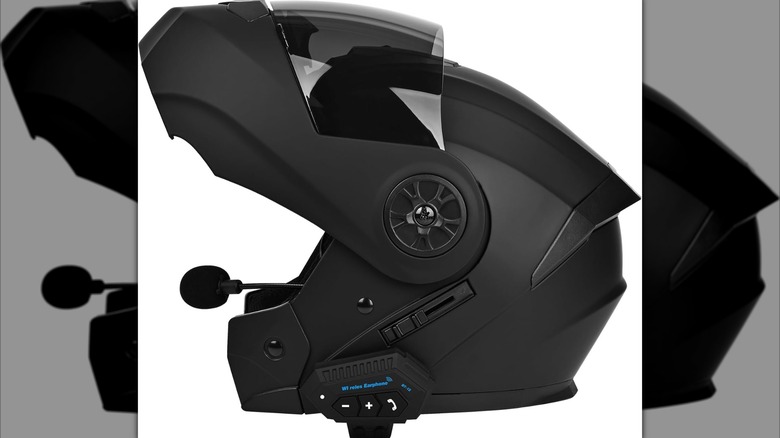Why Bluetooth Motorcycle Helmets Aren't Only For Bike-To-Bike Chat
We may receive a commission on purchases made from links.
Riding a motorcycle brings several advantages over driving a traditional car, but there's one thing that's a lot harder to do with the former than the latter: listen to music. When you're in a car, you're in a more-or-less sealed environment where you can enjoy your music with minimal interference from road noises. When you're on a motorcycle, you're constantly beset by the sounds of the road, your own engine, the wind wooshing past you, and so on. It's not exactly an environment conducive to easy listening, which is why you're more likely to find a rider with earplugs in than music playing.
There are a few potential ways to remedy this of varying quality; you could try attaching a speaker to your motorcycle dashboard, but the sound quality might not be sufficient. The only other obvious solution is to wear earbuds, but that's not safe to do while out on the road. So, what are you supposed to do if you want music on a bike? Well, there is one possibility: a motorcycle helmet with an integrated or attached Bluetooth headset. While these kinds of helmets are intended first and foremost for bike-to-bike communication with fellow riders on a trip, their built-in speakers could be used to listen to music. However, there are a few vital qualifiers to that potential, both technical and legal.
A Bluetooth helmet could be used as a convenient way to listen to music
Obviously, a Bluetooth-equipped motorcycle helmet incorporates some manner of two-way communication setup. There's a microphone and a speaker so you can speak to and hear other riders on the road. That said, some Bluetooth motorcycle helmets may also be able to sync up with your phone in the same way as a portable speaker or Bluetooth headphones. As long as your helmet's internal speaker is set up to receive wireless audio input, you can use it to listen to music.
Some Bluetooth-equipped helmets even have built-in buttons for controlling volume and skipping songs on your playlist. It's an essential piece of equipment for any Bluetooth-equipped rider. As long as you don't spend too long fiddling with buttons on your head while you're out on the road, it's a much safer way to listen to music than trying to look down on your phone. Just remember not to play your music too loudly, as you want to make sure you can still hear and perceive the road around you while you're driving.
Listening to music with a helmet may not be legal where you live
Here's the big asterisk on using a Bluetooth motorcycle helmet to listen to music: depending on where you live, listening to music in this way may actually be against the law. In the interest of road safety, some U.S. states do have laws that limit or prohibit the use of music accessories while out on the road.
The precise existence and language of these laws vary heavily from state to state. For example, in the state of Idaho, there are no particular limitations on the use of music accessories while riding a motorcycle, including headphones, earbuds, or Bluetooth helmets. On the flip side, the state of Colorado has a firm ban on all musical accessories that cover both ears while out on the road. You can still use a Bluetooth helmet to listen to music there, but only if the speaker system covers a single ear. One of the strictest states on this matter is Alaska, which completely prohibits the use of all headphones, headsets, and audio-equipped headgear in all vehicles. The only exception to this is for devices intended strictly for rider-to-rider communication, though it's a bit of a gray zone whether using such a device to listen to music would get you in trouble.
The bottom line is that, before you attempt to use a Bluetooth motorcycle helmet to listen to music, you should carefully check over your state's motor laws. If there's even a slight chance of legal trouble, it's not worth it.


